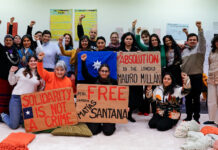Support LABLAB bring news from the frontline of Latin America’s struggles for social justice;
We make sense of a continent’s stories & promote media networks and partnerships. But we can only do this with your support. Please donate to make it possible to continue our work
This article was first published by Telesur. You can see the original here.
Header image: Fragment of an art piece explaining Wixarika cosmology by Jose Benitez Sanchez. The Wixarika are known for their colorful and meaningful art, as well as their constant struggle for land. Source: EFE
The sacred ceremonial island Tatei Haramara was sold to tourism companies without informing the Indigenous Wixarika people.
Members of the Wixarika Tatei Haramara Council of Nayarit, Mexico have denounced the illegal sale of one of their sacred ceremonial sites, Tatei Haramara island, to two “ghost” tourism companies.
Now, the island is out of reach for the Wixarikas (called “Huicholes” in Spanish because of the name given to them by the Nahuatl people), who can’t perform their religious duties there anymore nor have access to its water fountains, which has also caused severe health problems among them.
In 2011, the Paraiso del Rey and the Haramara tourism development companies bought almost a million square meters of the island through its legal representative, J. Guadalupe Gonzalez Renteria. He purchased Playa del Rey after he asked both federal and state authorities to relinquish the land’s public property status for a tourism development project.
According to council members, state Gov. Roberto Sandoval and environmental authorities “sold these sacred lands to two apparently ghost enterprises” to develop a tourism project including luxury hotels and a landing track.
Even though the sale took place in 2011, the development process has just begun.
The island is known in Spanish as Isla del Rey and is in front of the San Blas municipality in the state of Nayarit. It’s believed by the Wixarikas to be the place where the sea goddess Haramara first came out from the waters that covered the earth. It’s registered under Unesco’s Global Network of Sacred Natural Sites and considered a Protected Natural Area by the Mexican government.
They consider the island a temple where they used to perform ritual dances and ceremonies, but now most of it belongs to two enterprises with no former credentials. Council members claim the sale was made with the approval of Hilario Ramirez Villanueva, a former San Blas mayor, and his successor, Cipriano Pacheco, who are now investors in both tourism enterprises.
Now, members of surrounding Wixarika communities are demanding the government give them back their sacred lands and water fountains, on grounds that the sale was made without consultation, which is required by both local and international law.
“The water springs started drying in 2013 as their source was blocked and the water cycle was altered,” the council declared.
“Not having water access, the communities go instead to the river, already polluted by sewage and fuel, causing serious skin and internal organ diseases as well as the death of 15 people in just one community, children among them.”
Daniel Muñoz, legal representative of the Indigenous group, said they have sent a petition letter to the federal government asking for a complete halt of the tourism development plans.
They proposed that if the government wanted to develop a tourism project in the island, the Wixarika people could do that themselves, being respectful of their sacred sites and nature. “Its beauty is such and big companies want to own them to destroy them with their hotels and mines, but it will then stop being beautiful and turn into another slave for money,” the council said in a press release.
They also declared they were not acting against law or government, nor they were against other people’s beliefs, saying they are very respectful of churches and cathedrals in Mexico City and that the government should be as respectful of their sacred sites.
“We don’t disobey the rules and that’s why we ask why won’t you respect us and our sacred places if we do respect?” they asked. “The Wixarika people are not violent, we don’t want to violently defend our territory, but if that’s the only way, then we will know what to do.”
Wixarika artist and community leader Candelario Valadez has said that the island “is only a profitable piece of real estate land for tourism and speculational companies.”
The Wixarika people have been involved in several legal battles in defense of their territory, including the sacred sites in Wirikuta, a desert land where peyote is abundant, now threatened by Canadian mining and excessive tourism.
By Telesur / rfpl-RSF Copyright: Telesur
By Telesur / rfpl-RSF Copyright: Telesur




